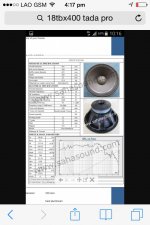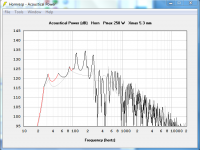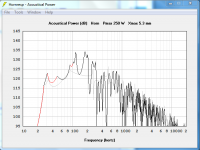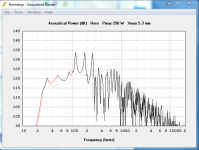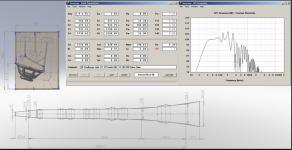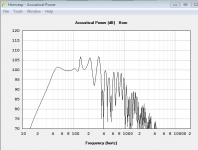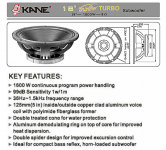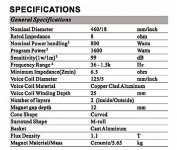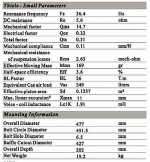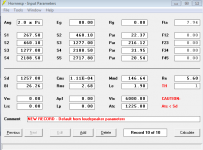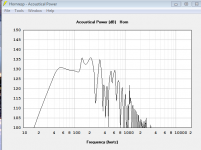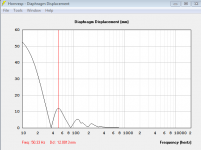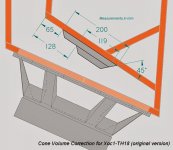Hi folks!
I'm based in Laos at the moment, which makes it difficult to access well known components for audio projects. I've recently discovered that I can pick up these 18" drivers for relatively cheap (120usd). They are branded as either Tada tbx400 or NTS 18 champ pro. They appear to be identical (apart from a small mesh guard the tada puts on the back of the magnet assembly.
Just wondering if some folks knowledgable in the sub arts could take a quick look at the TS parameters I've found and suggest what style of enclosure would work? I am a fan of horns (both tapped and flh) but am open to suggestions that suit the driver. I would aim for a 30-100hz pass band and have a mini dsp 4x10 for Eq. I would like to build a pair to use for garden parties, small club nights (under my yet to be completed 3 way synergy horns)
They only have 5mm or so of Xmax but quite a high power handling and sensitivity- so would a bandpass enclosure be something to investigate further? Penny for your thoughts?
Mark
I'm based in Laos at the moment, which makes it difficult to access well known components for audio projects. I've recently discovered that I can pick up these 18" drivers for relatively cheap (120usd). They are branded as either Tada tbx400 or NTS 18 champ pro. They appear to be identical (apart from a small mesh guard the tada puts on the back of the magnet assembly.
Just wondering if some folks knowledgable in the sub arts could take a quick look at the TS parameters I've found and suggest what style of enclosure would work? I am a fan of horns (both tapped and flh) but am open to suggestions that suit the driver. I would aim for a 30-100hz pass band and have a mini dsp 4x10 for Eq. I would like to build a pair to use for garden parties, small club nights (under my yet to be completed 3 way synergy horns)
They only have 5mm or so of Xmax but quite a high power handling and sensitivity- so would a bandpass enclosure be something to investigate further? Penny for your thoughts?
Mark
Attachments
Last edited:
That's odd, I can read it even without glassesEven blown up I can't read the specs clearly enough
Vas is a bit largish, Mms is a bit low, other then that it looks like a pretty all round driver to me. Xmax as most manufacturers calculate is with added gap depth, which would mean a Xmax of 8 mm in this case.
My initial guess would be either a tapped horn or a tapped horn reflex hybrid, with a low compression ratio and decent sized chamber.
Best regards Johan
Hi all,My initial guess would be either a tapped horn or a tapped horn reflex hybrid, with a low compression ratio and decent sized chamber
+1
Seems to be a good candidate for a Dynacord FX20 clone.
Regards,
Djim
That's odd, I can read it even without glasses
Lucky you, for me it's all faded/hazy when small and when expanded in its own tab it's just that much more so.
GM
Thanks! 'Old school' spec woofers, so gonna be big.
'Ran the numbers' and a BR is ~285 L net including a largish vent, with the 2:1 CR end loaded and offset driver THs ~543 L net.
Included a ~407 L 2.17:1 CR end loaded TL that may be the best choice overall, though would be reluctant to using much, if any, higher CR with such a high Vas.
Overlays are w/250 W, 5.3 mm Xmax.
I imagine Rademakers, Djim are much more current with what's probably best overall for prosound apps, but gives you some quick/easy builds to compare with.
GM
'Ran the numbers' and a BR is ~285 L net including a largish vent, with the 2:1 CR end loaded and offset driver THs ~543 L net.
Included a ~407 L 2.17:1 CR end loaded TL that may be the best choice overall, though would be reluctant to using much, if any, higher CR with such a high Vas.
Overlays are w/250 W, 5.3 mm Xmax.
I imagine Rademakers, Djim are much more current with what's probably best overall for prosound apps, but gives you some quick/easy builds to compare with.
GM
Attachments
@Djim- had a look at the dynacord FX20 you mentioned (and also at the Cubo sub which seems to fit the low compression ratio, large volume chamber format you recommended). I've got the driver info plugged into Horn response so can model some things but I have not been able to find any screenshots of the S1.2.3/ L1/2/3 parameters for either of these designs to copy. Not sure what values to assign the cabinet dimensions with the funny throat restriction in the S2-S3 region. Any tips? Do these designs afford the 30hz (35 at a pinch) extension i'm aiming for anyway? Any other cabinets I should add to my watch list?
@ GM- thanks for taking the time to post some potential designs! Any chance you have screenshots of the input parameters page to match the FR charts you posted? Would help me get a better sense of what is being proposed!
Cheers,
Mark
@ GM- thanks for taking the time to post some potential designs! Any chance you have screenshots of the input parameters page to match the FR charts you posted? Would help me get a better sense of what is being proposed!
Cheers,
Mark
Just out of interest- have been throwing the driver into some saved cabinet designs I have in HR just for fun (that and trying to manually fold horns does my head in!) . It actually plays fairly well in an early version of what I think became Xoc's TH18.
I input the data from this image (apologies to GM for the poor resolution)
and got the following FR chart:
It has more of a 40hz extension (but to be honest the 30Hz cabs looked like they were going to be just enormous and impossible to move!)
Do you think I would run into issues with the Compression Ratio if I went with something like this? I believe the Xoc cab had a 2.5-1 CR.
@GM- many thanks for passing along the text files for HR. Need to spend some more time with them before I fully see what the trade offs are with the designs. The 407L cab is attractive because of it's size relative to the others. Any tips on what sort of fold might work with it?
Mark
I input the data from this image (apologies to GM for the poor resolution)
and got the following FR chart:
It has more of a 40hz extension (but to be honest the 30Hz cabs looked like they were going to be just enormous and impossible to move!)
Do you think I would run into issues with the Compression Ratio if I went with something like this? I believe the Xoc cab had a 2.5-1 CR.
@GM- many thanks for passing along the text files for HR. Need to spend some more time with them before I fully see what the trade offs are with the designs. The 407L cab is attractive because of it's size relative to the others. Any tips on what sort of fold might work with it?
Mark
Attachments
I think that version has a lower effective compression ratio, due to the cone volume not being accounted for in the fold.I believe the Xoc cab had a 2.5-1 CR.
Do you think I would run into issues with the Compression Ratio if I went with something like this?
@GM- many thanks for passing along the text files for HR. Need to spend some more time with them before I fully see what the trade offs are with the designs. The 407L cab is attractive because of it's size relative to the others. Any tips on what sort of fold might work with it?
Mark
You're welcome!
??? your sim shows a 1.83:1 Vs my 2.17:1 CR. With these 'vintage' spec drivers, 2:1 CR is the limit I've seen the pioneers use, so without testing I'm not a 100% even sure 2.17:1 is 'bulletproof' down below Fs, but assumed a hi-pass would be used to protect it, ergo going higher may require a higher point, somewhat negating the sub's lower extension. ~quoting 'Dirty Harry' then, "Do you feel lucky today?"
Don't know that there's any particular way of folding that's better, though for a bass alignment you want to attenuate as much of its out-of-passband response as much as practical, so the more [sharp] bends the better, but for portability the size/shape factor normally dominates.
FWIW, I use[d] 'accordion' folding for long TLs, FLHs same as the pioneers except a TH will be folded back on itself of course, so apparently still the folding of choice judging by some the prosound THs I've seen and ~what you posted.
Anyway, some info on folding and a designer:
http://www.diyaudio.com/forums/subwoofers/297309-tapped-horn-3d-model-automatic-folding.html
http://www.diyaudio.com/forums/subwoofers/171747-spreadsheet-folded-horn-layouts-5.html#post4443437
GM
Just got back from another reconnaissance mission to Thailand- this time with a friend who spoke a bit of Thai so I was actually able to get a bit more useful info out of some store owners.
The Tada/NTS driver had some obvious limitations- minimal Xmax 6.5m which would only allow 250W of power before running into excursion issues. Large VAS and a low MMS were also concerns. With that in mind I chased down some info on some of the other drivers available in the stores. One of the more interesting ones is this one- branded as a Kane 'Turbo'. 11mm xmax, and a slightly higher MMS (at 169 gram) an lower VAS. I'll attach the data sheet to this post for your info.
I know that this driver is still a good 100 grams short of the recommended driver MMS for the TH18 (but this driver would only be getting 800w RMS instead of the recommended B&Cs 1700!).
The horn response charts I quickly did this afternoon showed a good FR, and kept everything within XMAX for the power handling.... at $160 US per driver is it worth a punt?
Mark
The Tada/NTS driver had some obvious limitations- minimal Xmax 6.5m which would only allow 250W of power before running into excursion issues. Large VAS and a low MMS were also concerns. With that in mind I chased down some info on some of the other drivers available in the stores. One of the more interesting ones is this one- branded as a Kane 'Turbo'. 11mm xmax, and a slightly higher MMS (at 169 gram) an lower VAS. I'll attach the data sheet to this post for your info.
I know that this driver is still a good 100 grams short of the recommended driver MMS for the TH18 (but this driver would only be getting 800w RMS instead of the recommended B&Cs 1700!).
The horn response charts I quickly did this afternoon showed a good FR, and kept everything within XMAX for the power handling.... at $160 US per driver is it worth a punt?
Mark
Attachments
Screen grabs from quick Horn Response model (2.0xPI).
Single XOC TH-18 (original design) with 800W RMS.
Very similar FR chart to that given on the DIY subwoofer page (using 18sound 18LW2400-http://www.diysubwoofers.org/projects/diyaudio/TH18/ )
Single XOC TH-18 (original design) with 800W RMS.
Very similar FR chart to that given on the DIY subwoofer page (using 18sound 18LW2400-http://www.diysubwoofers.org/projects/diyaudio/TH18/ )
Attachments
Thanks for the piece of mind GM!
I am picking up two drivers from Thailand tomorrow and already have one of the cabs pretty much stitched up (apart from the baffle which I have yet to do the cut out and install.) I've been asked to DJ a new years event at a local bar which should be fun- Hopefully these will be all ready to go in time for then!
One issue i've yet to decide on is the inclusion of extra material for cone correction. I know that accurate and proper simulation (and subsequent modification of the cabinet design) is a sure fire way to do away with it all together- however the process of re-drawing and scaling a relatively complex cabinet makes it less appealing. In the XOC flat to 35 thread there were some suggestions. One which was slated as being appropriate for both weak and strong motors (i'm guessing this is to do with CR right?) was the following.
Before I stick the other side on do you think I should include it (it would make my rather pedantic weight reduction cut out pattern in the braces a little redundant- but then again so will the 16KG driver)
Thanks everyone for your input,
Mark
I am picking up two drivers from Thailand tomorrow and already have one of the cabs pretty much stitched up (apart from the baffle which I have yet to do the cut out and install.) I've been asked to DJ a new years event at a local bar which should be fun- Hopefully these will be all ready to go in time for then!
One issue i've yet to decide on is the inclusion of extra material for cone correction. I know that accurate and proper simulation (and subsequent modification of the cabinet design) is a sure fire way to do away with it all together- however the process of re-drawing and scaling a relatively complex cabinet makes it less appealing. In the XOC flat to 35 thread there were some suggestions. One which was slated as being appropriate for both weak and strong motors (i'm guessing this is to do with CR right?) was the following.
Before I stick the other side on do you think I should include it (it would make my rather pedantic weight reduction cut out pattern in the braces a little redundant- but then again so will the 16KG driver)
Thanks everyone for your input,
Mark
Attachments
Hmm, apparently this extra volume has already been accounted for in the sim, i.e. Vtc, so no need for any compensation if 6000 cc is about right; otherwise adjust this number to see how it affects the response using the max SPL tool in the 'acoustic power' window to see if it affects the Xmax limit portion of the BW. Relying only on the max voltage calculated response seems a 'recipe for disaster' to me.
Anyway, I only know it doesn't make any worthwhile difference in compression horns until the CR gets beyond 3:1 IME, though admittedly these were loaded with much lower power cone drivers [15"/150 W peak at most].
Still, 2:1 basically only covers the surround and just a little of the outer rim of the diaphragm, so really mild in the scheme of things and only affects/damps a portion of its HF BW, which will be well above a TH's passband, so a good thing.
GM
Anyway, I only know it doesn't make any worthwhile difference in compression horns until the CR gets beyond 3:1 IME, though admittedly these were loaded with much lower power cone drivers [15"/150 W peak at most].
Still, 2:1 basically only covers the surround and just a little of the outer rim of the diaphragm, so really mild in the scheme of things and only affects/damps a portion of its HF BW, which will be well above a TH's passband, so a good thing.
GM
Been a while away from this thread but thought I would update. So once I had the drivers I was able to knock up the cabinets pretty quickly. It all went together pretty easily.
Did some very quick testing in my front yard and was getting some FR responses that were confusing to say the least- huge null at 80hz. Eventually clued onto the fact that it was due to a node caused by the 8ft concrete walls that surround our house. Some low level sweeps at the horn mouth confirmed the response was in line with the simulations.
Here is where it gets annoying- so it turns out the data sheet was telling porkies and the driver only has 11mm of p-p excursion, not 11mm+- (22mm p-p). So even with my piddly little HT plate amps (150rms) I can drive the units to the drivers limit. The cabs sound ok until it hits this level but everything starts to go pear shaped after that. Hard to justify the heft of the cab for the output it is able to produce to be honest.
Hard to justify the heft of the cab for the output it is able to produce to be honest.
Not sure what to do- anyone have any ideas what I could do with them?
Did some very quick testing in my front yard and was getting some FR responses that were confusing to say the least- huge null at 80hz. Eventually clued onto the fact that it was due to a node caused by the 8ft concrete walls that surround our house. Some low level sweeps at the horn mouth confirmed the response was in line with the simulations.
Here is where it gets annoying- so it turns out the data sheet was telling porkies and the driver only has 11mm of p-p excursion, not 11mm+- (22mm p-p). So even with my piddly little HT plate amps (150rms) I can drive the units to the drivers limit. The cabs sound ok until it hits this level but everything starts to go pear shaped after that.
Not sure what to do- anyone have any ideas what I could do with them?
Hmm:
Xmax = (Voice Coil Length - Height of the Magnetic Gap) / 2
Xmax = [25-12]/2 = 6.5 mm
Yep, you're right 'we' should have paid more attention to the specs.
Well, the specs are near enough perfect for a 1930s era 105 dB eff. ground plane 30 Hz bass horn, but at nearly 10 k L, guessing it's not an option.
The pioneers didn't have much need for deep bass, so designed for max mid bass eff., so if you build for reflex max power handling it won't make as much bass, but it's 'only' ~181 L net with both it and the TH good for 600 W peaks @ 6.5 mm down to Fs according to HR, so not sure why they're 'dying' @ only 150 W unless there's an air leak.
GM
Xmax = (Voice Coil Length - Height of the Magnetic Gap) / 2
Xmax = [25-12]/2 = 6.5 mm
Yep, you're right 'we' should have paid more attention to the specs.
Well, the specs are near enough perfect for a 1930s era 105 dB eff. ground plane 30 Hz bass horn, but at nearly 10 k L, guessing it's not an option.
The pioneers didn't have much need for deep bass, so designed for max mid bass eff., so if you build for reflex max power handling it won't make as much bass, but it's 'only' ~181 L net with both it and the TH good for 600 W peaks @ 6.5 mm down to Fs according to HR, so not sure why they're 'dying' @ only 150 W unless there's an air leak
GM
Last edited:
Hi GM!
Yes I should have been less hasty and looked at the specs with a bit more of a critical eye- I had just got some free time and was keen to crack on
Lesson learned.
I initially thought that there might be a leak too (between driver and baffle) and that might be contributing to the poor power handling/excursion issues. But both cabs presented in exactly the same way. Starting to get that boxy tone as soon as the driver limits were reached (same power each channel). I took care to ensure there were no panel leaks during construction and had significant squeeze out on all my joins so I don't think it is an internal problem.
A simple sealed box might be a quick and easy experiment for me to muck around with (I can do a linkwitz transform to increase low end output with my mini dsp). Might be able to fit two of them in my car with the rest of my gear too (the 2x TH18s don't play nicely with my Suzuki vitara's cargo space!)
Yes I should have been less hasty and looked at the specs with a bit more of a critical eye- I had just got some free time and was keen to crack on

Lesson learned.
I initially thought that there might be a leak too (between driver and baffle) and that might be contributing to the poor power handling/excursion issues. But both cabs presented in exactly the same way. Starting to get that boxy tone as soon as the driver limits were reached (same power each channel). I took care to ensure there were no panel leaks during construction and had significant squeeze out on all my joins so I don't think it is an internal problem.
A simple sealed box might be a quick and easy experiment for me to muck around with (I can do a linkwitz transform to increase low end output with my mini dsp). Might be able to fit two of them in my car with the rest of my gear too (the 2x TH18s don't play nicely with my Suzuki vitara's cargo space!)
- Status
- This old topic is closed. If you want to reopen this topic, contact a moderator using the "Report Post" button.
- Home
- Loudspeakers
- Subwoofers
- What enclosure type for this LF driver?
